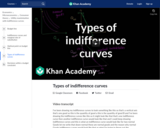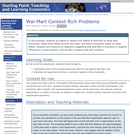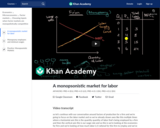
Indifference curves for normal goods, substitutes and perfect complements. Created by Sal Khan.
- Subject:
- Economics
- Social Science
- Material Type:
- Lesson
- Provider:
- Khan Academy
- Provider Set:
- Khan Academy
- Author:
- Sal Khan
- Date Added:
- 07/27/2021

Indifference curves for normal goods, substitutes and perfect complements. Created by Sal Khan.

Microeconomics may be most accessible to students when instructors can pull current events into the classroom. Teaching the course online makes doing so easier but brings new challenges in graphing, engagement and assessment.
This collection of resources can be utilized by experienced faculty or instructors with minimal teaching background or years of experience in the classroom. Novice instructors may appreciate faculty developed activities, text alignment and videos, while new-to-online faculty will benefit from suggestions of easy-to-use online tools for polling and graphs. The development team included activities for individual students, as well as team exercises and discussion starters.

Microeconomics course collection video from the UNC System OER project. This one-minute video is meant for students. It focuses on what students may think they know about the topic, what students could learn from taking the course, and a brief introduction to open educational resources.

In the video we explore why the marginal utility per dollar spent should be equal for the last increment of either good purchased. Created by Sal Khan.

In the video we explore why the marginal utility per dollar spent should be equal for the last increment of either good purchased. Created by Sal Khan.

Video assignment related the economic concept of Perfect Competition using a CBS - 60 Minutes segment.

Graphing variable cost, fixed cost and total cost. Created by Sal Khan.

This video shows how we can visualize marginal utility (MU) and total utility (TU) functions graphically.

In this example, students are asked to research the effects of Wal-Mart on small town economies, relate those effects to their own town, and draw a conclusion based on those effects.

What if there were no prices? How would you use available resources? In this video, Professor Howard Baetjer Jr. of Towson University leads you through a thought experiment to illustrate why market prices are essential to human well-being. Suppose you were the commissar of railroads in the old Soviet Union. Markets and prices have been banished. You want a railroad from City A to City B, but between the cities is a mountain range. You can build the railroad around the mountains and use more steel or through the mountain and use more engineering. Which should you choose?

In a previous lesson we learned that there is the potential for two countries to gain from trade. But it is also possible that there might not be the potential to gain from trade. In this video, we explore the circumstance that would lead to there being no gains from trade.

Why do we exchange things? In this video, Professor Michael Munger of Duke University explains that exchange helps correct mistakes in the allocation of resources and makes everyone involved happier.

In this video, we explore a conflict that duopolists (and other oligopolies) face: there is a tension between cooperating and forming a cartel or cheating on that cartel once it is formed. Created by Sal Khan.

A Netlogo implementation of Gode and Sunders (1993) ZI-Trading model. Students explore whether efficiency in the market is determined by the market or by human rationality.

Every time a firm hires more labor, they get more output which means more revenue. In this video we begin thinking about how much incremental benefit a firm gets from hiring one more person. Created by Sal Khan.

When there is a single buyer of labor this type of market is called a monopsonistic labor market. Learn how this changes the analysis of labor markets and why marginal factor cost is higher than the supply of labor in such markets.